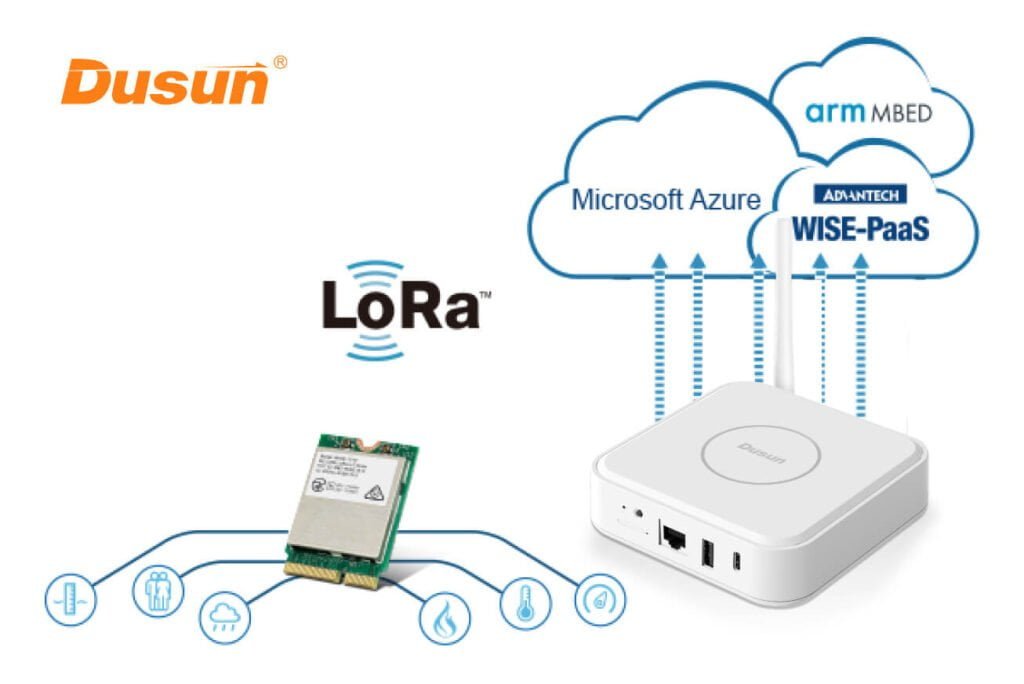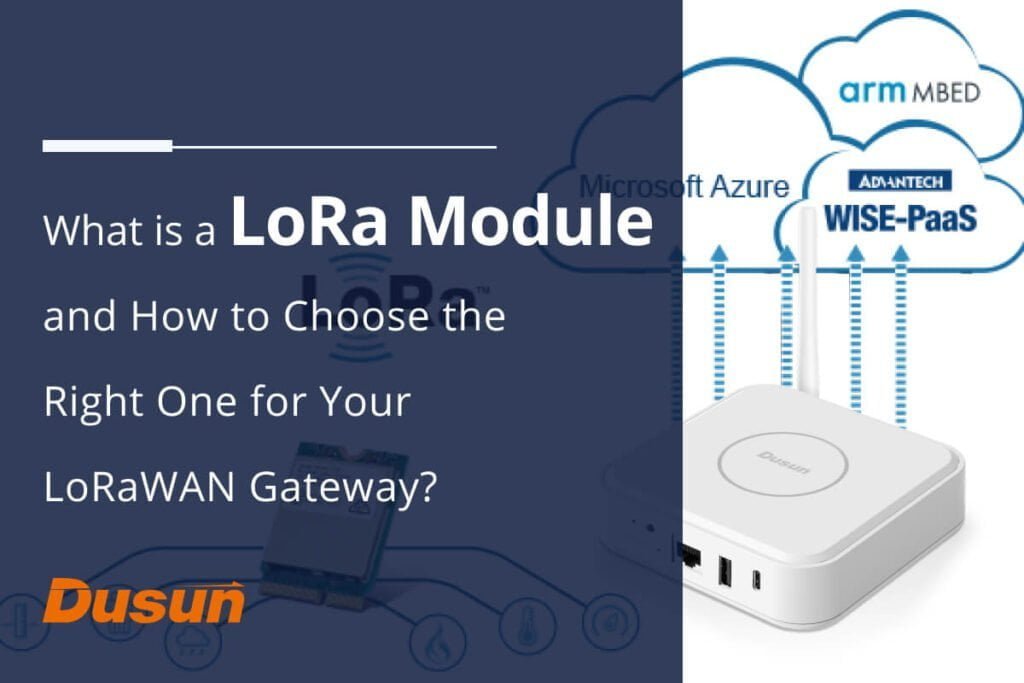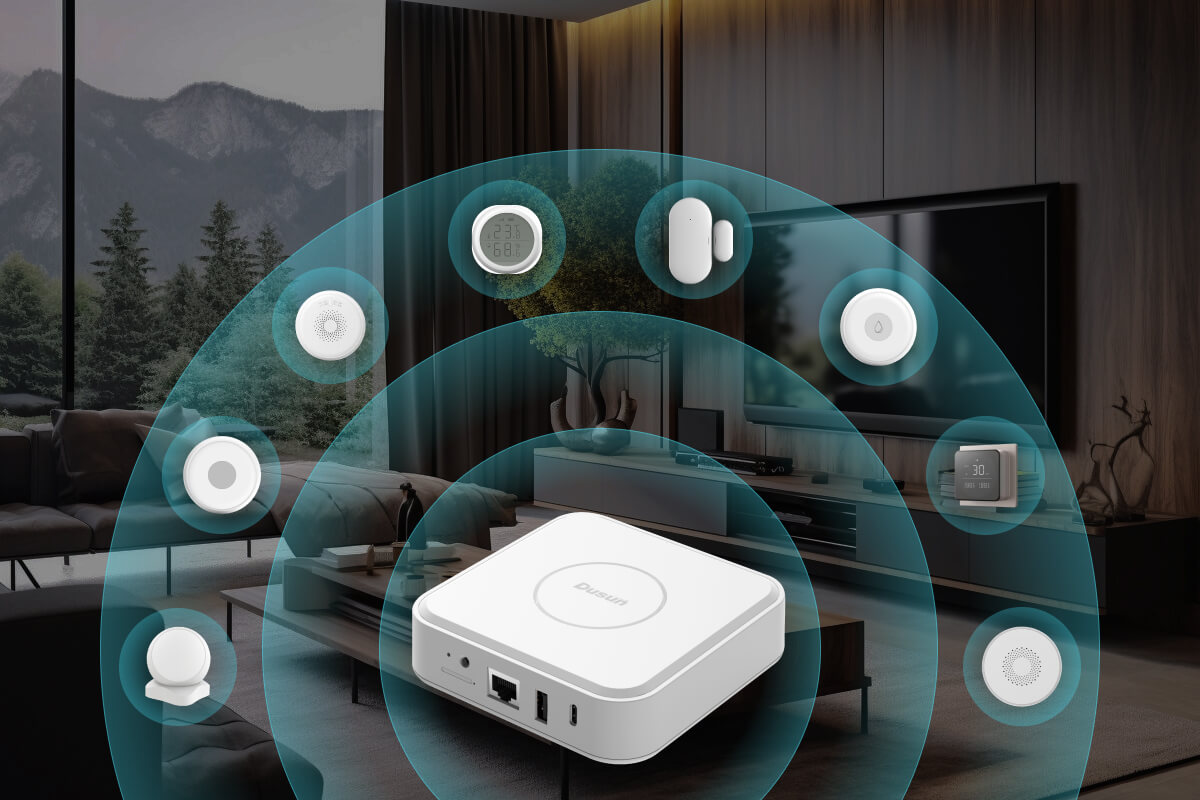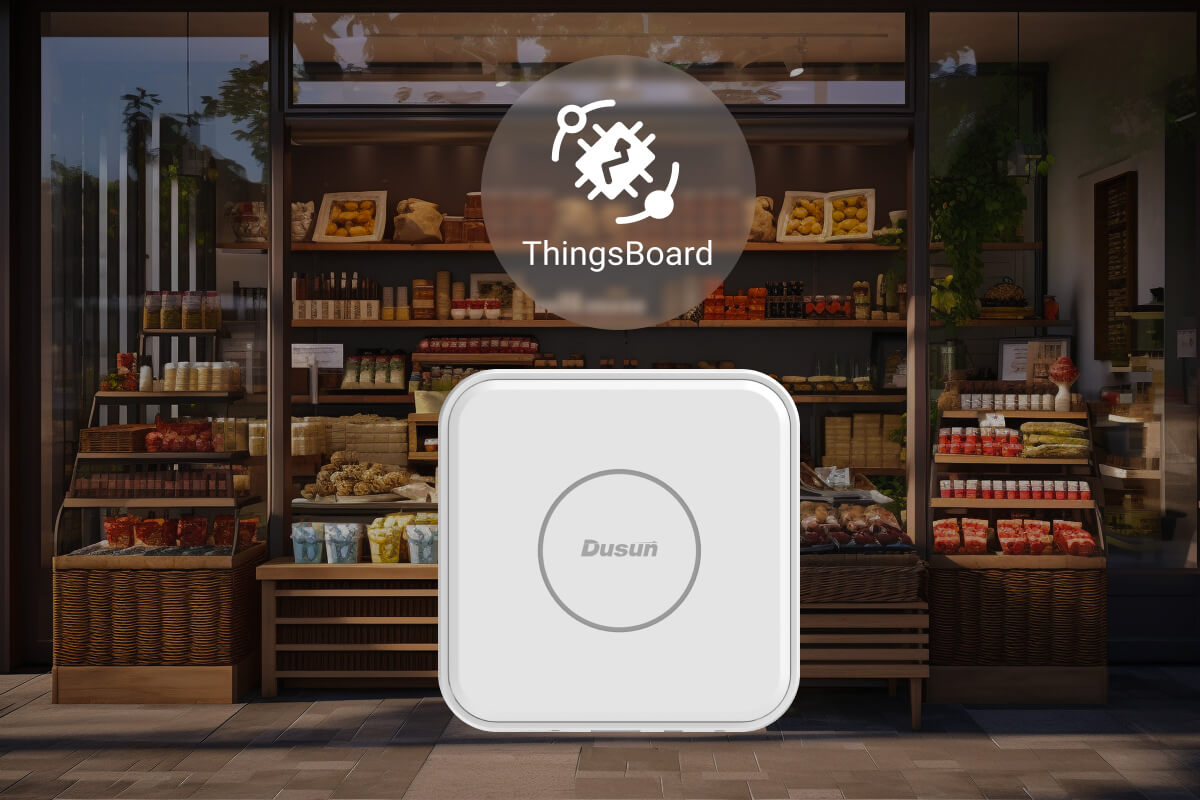If you are searching for an affordable and scalable LoRa Gateway solution for your smart home technology, smart agriculture, smart tracking, smart building, and smart city applications, the LoRa module is the key component that you need. LoRa Module is a low-power method that you can use to enhance communication between IoT devices or smart homes and the network server. It enables your your IoT (Internet of Things) communications network more secure and even faster.
So, what is a LoRa module and how do you choose the right LoRa module for your LoRaWAN gateway? Keep reading to find out.
What is LoRa Module?

LoRa (Long Range) Module is a wireless communication module developed base on Semtech chips. It allows your IoT devices to communicate with LoRaWAN network.
LoRa is an LPWAN (low-power wide-area network) protocol developed by chip manufacturer Semtech. It sits at the physical layer, layer 1, of the seven-layer Open System Interconnection (OSI) model of a computer network. Lora is a wireless modulation system hinged on CSS (Chirp Spread Spectrum) technology. For instance, it encodes radio wave information using a chirp pulse, similar to how bats and dolphins communicate! The LoRa modulation transmission, in particular, is robust against disturbance. The modulation can be received across long distances depending on the hardware capabilities. Besides, the modulation means you do not need to write a code to implement the radio system.
Lora is perfect for applications that have small data chunks with low bit rates. Data can be transmitted over a long distance compared to wireless technologies like Bluetooth, ZigBee, or WiFi. This makes LoRa well-suited for sending sensor and actuator data in low-power modes.
You can operate LoRa on the license-free sub-gigahertz wireless spectrum like 433 MHz, 868 MHz, and 915 MHz. It can also be used on 2.4 GHz to achieve much higher data rates at the cost of the distance (range). These frequencies fall into the ISM bands, which are internationally reserved for medical, scientific, and industrial purposes.
How Does LoRa Work?
LoRa works by moving an RF (Radio frequency) tone around over time in a linear way.

The above graph demonstrates the chirps in a reverse waterfall. For instance, the newest (latest) data is at the top, and it is called an up chirp. You can notice how this RF of the tone is increasing over time. Therefore, LoRa transmission works by chirping. This entails breaking the chips in various places in terms of frequency and time to encode a symbol.
Since LoRa transmissions move from one place to another at a certain time, it would mean a one-bit string versus another. However, it is not just about binary; it has more information (high symbol depth) you can convey. Think of a pure FSK (frequency shift keying). If an RF one is stationary for some time and then moves (jumps) to another place, you will notice (see) different lines. The tone is known as 2-ary FSK, which means two frequency symbols. M-ary denotes multiple frequency tones and can represent even more frequency symbols.
LoRa has inherited this concept. The only difference is it does everything on a chirp. Therefore, it is getting processing gain. Since LoRa has a very distinct pattern, its receiver can detect quieter chirps, such as below the noise floor.
Types of LoRa Modules
Here are the types of LoRa modules that you can choose from:
- The basic transceiver LoRa module: This is the earliest form of LoRa module. You can access its register using a Serial Peripheral Interface (SPI) interface to the transceiver. The host controller has all the required commands to set up the transceiver.
- The full-blown LoRa module: This is a more advanced type of LoRa module that features a host controller. It can be utilized for single-controller applications. A UART (Universal asynchronous receiver-transmitter) interface is normally used to access them.
- Modem: This is another type of LoRa module. It has a LoRaWAN stack already installed. You can use an AT-type command to get access through a serial UART (Universal asynchronous receiver-transmitter) interface.
Lora Module Features
Some of the LoRa modure features include:
Chirp Spread Spectrum Modulation to Achieve High Range But Low Power
LoRa module uses a chirp spread spectrum modulation technique to attain a significantly high communication range. However, it maintains low power characteristics similar to the FSK modulation layer-based radios.
Although the chirp spread spectrum modulation has been around for some time, LoRa represents this technique’s first low-cost commercial application.
Worldwide Avaliable Frequency But Different in Countries
Although LoRa technology is frequency skeptic, communication between LoRa radios occurs through an unlicensed sub-gigahertz radio frequency band. These frequencies are available around the world. However, they differ between countries and vary from region to region. For instance, the 915 MHz is used for LoRa communications in North America, while 868 MHz is commonly used in Europe. Irrespective of the frequency, you can use LoRa module without any major technological variation.
Adaptive Data Rate Through Spreading Factors and Variable Bandwidth
LoRa uses spreading factors (SF7-SF12) and variable bandwidth to adapt the data rate in a trade-off with the transmission range. A lower spreading factor allows a shorter range at the expense of a higher data rate and vice versa.
The spreading factor and bandwidth can be chosen based on the transmitted data level and the link condition. So, a higher spreading factor (SF) improves sensitivity and transmission performance for a particular bandwidth. It also increases the transmission time due to lower data rates.
Adaptive Power Level to Maintain Network Capacity and Battery Life
The power level employed by LoRa is adaptive. It depends on various factors, such as link conditions and data rate. For instance, when a fast transmission is needed, the transmitted power is driven closer to the maximum, and vice versa. As such, the network capacity is maintained, and battery life is maximized.
LoRa Module Advantages
LoRa module has the following advantages:
- Low cost: LoRa module has an unlicenced spectrum and uses constant envelope modulation. So, the price is pocket-friendly.
- Easy commissioning: LoRa module has a simple architecture that is easy to deploy in an existing network.
- Long range: It has a wide coverage range. For instance, it can cover a communication distance of up to 5km in urban and 15km in suburban areas.
- Low power: LoRa module does not consume much power and can run on battery for a long time.
- Bi-directional: It can send and receive data.
- Universal: It is globally available.
- Network scalability: It supports thousands of messages per station, making it easy to scale.
LoRa Module Disadvantages
LoRa module has the following disadvantages:
- Low bandwidth: The LoRa WAN is limited in size. Besides, it is only suited for short and periodic communications.
- Spectrum interference: The continuous development of LoRa and LoRa equipment causes a constant increase in network deployment. So, the spectrum interfaces will crop up between each other.
- Low transmission rate: There is a higher transmission distance in wireless communication. However, the transmission rate is low due to LoRa’s long transmission distance.
- Not ideal for some IoT applications: Real-time applications that need low boundancy jitter and latency can not use LoRa.
Difference Between LoRa and LoRaWAN
Many people tend to think LoRa and LoRaWAN mean the same thing. However, although they are often used synonymously, they have different meanings. The difference between LoRa and LoRaWAN comes down to the telecom device layer that the network interacts with.
For instance, LoRa (Long Range) is a radio signal that interacts with the device’s physical layer. So, if you have a LoRa basics modem, you can easily convert your data into transferrable signals. Its architecture allows the long-range communication link. LoRa also improves receiver sensitivity and has a wide communication range.
On the other hand, LoRaWAN is what links or connects the LoRa signal to the application. It controls both the protocol and architecture by allowing you to track the security of transferred data, network capacity, and even the node’s battery life. LoRaWAN enables you to use IoT (internet of things) devices better while still facilitating data transfer to the cloud.
LoRaWAN and LoRA offer the functionality that determines network capacity, security, quality of service, battery life of a node, and other applications served by the network.
Lora vs Sigfox vs Zigbee vs Wi-Fi
In this section, we have compared LoRa with other IoT modules to help you understand why the LoRa module is better.
LoRa vs Sigfox
Although Sigfox covers a smaller area than LTE-M, it is specially designed for low-data transfer devices. It also offers a completely different network for IoT devices. On the other hand, LoRa strikes a balance between data rate, coverage area, and power usage because of its Chirp Spread Spectrum (CSS) modulation.
LoRa vs Zigbee
LoRa can be used in low-power applications with lower data rates and longer distances. On the other hand, ZigBee can be used in high data-rate applications that require a mesh network.
LoRa vs Wi-Fi
WiFi is superior in bandwidth but struggles with range and battery life. This makes it not ideal for scattered IoT devices. On the other hand, LoRa has a long-range and low-power nature, which makes it suitable for scattered IoT applications.
How LoRa Modules Work in An IoT Gateway Solution

As the above image shows, there are four main elements:
- End-node: sensors with embeded LoRa module that gather, receive, and transmit data to LoRa gateway. They are battery-powered and remotely connected.
- The LoRa gateway: This is a transparent LoRa bridge between the network server and end nodes. Technically, end-nodes connect to the gateway with embeded LoRa module, while the LoRaWAN gateway connects to the networks using high-bandwidth networks like cellular, Ethernet, or WiFi to connect to the network.
- A network server: This connects to multiple LoRaWAN gateways and gathers data from the gateways. It then filters out duplicate messages and determines the LoRaWAN gateway that should respond to end-node messages. Finally, it adapts data rates that help extend the battery life of the end nodes.
- The application server. It collects data from the end nodes. It then controls the activities of the end-node devices.
LoRa Module Use Examples
There are many application areas where the LoRa module can be used with private and public networks. It is ideal for low-power and long-range system needs.
Smart Agriculture Using IoT
Farms usually have a wide area to cover for any Internet of Things (IoT) system architecture. And a shorter communication range results in more IoT gateways. This increases the overall system architecture cost. So, the LoRa module can be the best option. This is because outdoor LoRaWAN gateways with lower power consumption and longer range can serve the need precisely.
Therefore, the benefits of using the LoRa module in agriculture would include lesser operational costs, simpler maintenance, and simpler network architecture. Here we provide an introduction on IoT agriculture system based on LoRaWAN.
IoT-based Energy Meter Reading
The intelligent meter reading is another application area where the LoRa module can be used. For instance, installing a LoRa module into your smart water meter or smart electricity meter allows you to remotely obtain the water or electricity meter data without meter readers reading the data one by one.
The LoRa module and LoRa gateway allow for direct transmission of meter data to the management background. So, the remote control center can charge the corresponding electricity and water charges according to these meter reading data.
Smart Parking System Using IoT
The traditional car parking systems, especially in populated and crowded areas, are now a thing of the past. For instance, those manual ticketing systems devices caused poor economic and time productivity and provided lesser features.
However, you can reserve car parking slots with smart parking sensors (LoRa modules). Besides, it allows management to detect any accident easily and monitor parking individually.
IoT-based Smart City
Smart city applications include a wide range of networks with long-range requirements. So, the LoRa module can be used for smart city applications, such as:
- Traffic congestion tacking
- noise mapping solutions
- structural health monitoring
- energy monitoring networks
- water quality monitoring systems
- streetlight control
For instance, all these software solutions require longer communication ranges than WiFi and Bluetooth networks. So, LoRa would be an effective, perfect, and inexpensive option.
IoT Building Management
The current industries are all about monitoring, analytics, automation, and connectivity. And they mostly use actuators and smart sensors. Therefore, LoRa modules help ensure that these smart devices have Internet of Things (IoT) connectivity and sustainable power consumption. These IoT ecosystems may include numerous sensors, such as light, humidity, gas, temperature, and other similar sensors.
So, you can use LoRa modules for employee management, access control, fire detection, security, or anything as simple as remotely controlled devices.
Further Reading: Smart Apartment Building Management Based on IoT technology
LoRa Tracking
You can also use LoRa modules smart tracking systems, such as:
- Asset tracking systems
- Warehouse management system
- Machine monitoring solutions
- Fault management systems
- Triangulation-based GPS location tracking systems
You can also use LoRa module to build smart supply chains and logistics.
For instance, using traditional methods can take a long time and consume huge material and human resources. So, LoRa’s long-distance, low cost, low power consumption, and other technical characteristics make it an ideal choice for smart tracking applications.
Things to Consider When Choosing the Right LoRa Module
With so many LoRa modules available in the current smart device market, it can be challenging to tell a good or best LoRa to use for your industrial or personal use. If you are looking to select the right LoRa module for your LoRaWAN Gateway, a good or best LoRa module has the following characteristics:
Strong Anti-interference and High Sensitivity
Strong and–interference is one of the characteristics of the best LoRa wireless module. Besides, since LoRa modules use spread spectrum technology, the best LoRa module should have a high sensitivity of -139dBm.
Low Power Consumption
The designers of wireless products focus on increasing battery capacity, reducing power consumption, and prolonging the battery service life. Therefore, the best LoRa module should have a low power consumption. This ensures plunged service life of the LoRa module and significant savings of energy.
Long Transmission Range
The open transmission range of the best LoRa module should be more than 5000 meters. This is vital in solving the problem of long-distance and low power consumption.
The Best LoRa Modules for LoRaWAN Gateway
Here are our top three picks for the best LoRa module for LoRaWAN Gateway:
Semtech LR1120
The Semtech LR1120 is a LoRa edge module that supports LR-FHSS (Long Range – Frequency Hopping Spread Spectrum) communication over 2.4 GHz ISM and over 150 – 960 MHz bands and licensed S-Band for satellites.
The module has an Rx sensitivity of up to -144dDm and a Tx power output of up 22dBm. It also needs a DC power supply of 1.8 – 3.7 volts. Besides, it consumes less than 118mA of electric current.
This LoRa module is perfect for intercontinental logistics, recovery, multi-regional asset location, traceability inventory management, theft prevention applications, and asset loss.
- Frequency: 434 – 915 MHz / 2412 – 2484 MHz
- Data rate: 1 to 2 Mbps
- Supply voltage: 1.8 to 3.7 V
- Modulation: FSK, DBPSK, GFSK, BPSK
- Power output: Up to 22 dBm
- Mounting type: Surface Mount
KYOCERA AVX – ETH-LORA-M-AX-01
This LoRa module works in the unlicensed 868 to 915 MHz band. It maximizes the power transfer between the antenna and the radio by combining the Semtech LoRa module SX1272 with the advantages of Ethertronic Active Steering technology and a matching impedance solution.
This low-power LoRa module provides 14 – 19 dBm of output power. This results in a sensitivity of up to -138 dBm and a link budget of over 156 dB. The module is perfect for Smart Grids, Smart Metering, Telemetry, Smart City, and IoT applications.
- Technology: LoRa
- Interface type: UART
- Sensitivity: -138 dBm
- Power output: 14 – 19 dBm
- Supply voltage: 2.5 – 3.6 volts
- Frequency: 863 to 915 MHz
IMST – iM881A-XL
This low-power, compact, bidirectional LoRa module works from 863 – 870 MHz in the unlicensed band. The module can achieve a range of up to 12km in free space and has an excellent sensitivity of -138 dBm. It consumes a current of 28 mA and needs an operating voltage of 1.8 – 3.6 volts to deliver an output power of up to +13 dBm.
It is perfect for application areas like wireless networks, automated meter reading, wireless alarm and security systems, telemetry, wireless sensors, remote control, and building/home/ industrial automation.
- Frequency: 863 – 870 MHz
- Technology: LoRa
- Supply voltage: 1.8 – 3.6 volts
- Integrated antenna: NO
- Output power: 15dBm
- Data rate: 0.24 – 50 Kbps
- Interface type: I2C, SPI, UART
Tips for Choosing the Right LoRa Module for Your IoT Projects
You should consider various factors while selecting the right LoRa module for your project. Some of the vital factors include;
- Personal preference
- Field coverage
- Application area
- Indoor or outdoor
- Security
- Budget
- Capacity
- Data transmission
- Interoperability
- Backhaul
Even as you consider the above factors, it is highly recommended to conduct extensive testing to ensure that the LoRa module you choose is working optimally.
Lora Module Manufacturers and Suppliers
Semtech is the chief owner of the LoRa intellectual properties. It, among others, sell (supply) LoRa modules, gateways, and receivers. Other top LoRa module manufacturers include:
- STMicroelectronics
- Microchip
- Mcf88
- AllThingsTalk
- Gumstix
- Adeunis
- Netvox Technology
- Telit
- Libelium
- Yokogawa Electric Corporation
The choice of LoRa module manufacturer or supplier depends on the LoRa use case, the region you are in, and the type of application.
Bottom line
It is vital to select the right LoRa module for your LoRaWAN gateway. If you find it challenging to choose the best LoRa module, Dusun IoT’s experts will help enhance your smart home device toolkit with on-demand smart solutions and devices. Do not hesitate to contact us!














